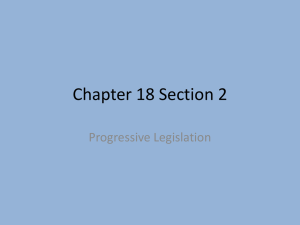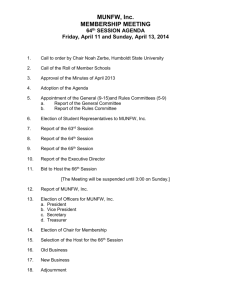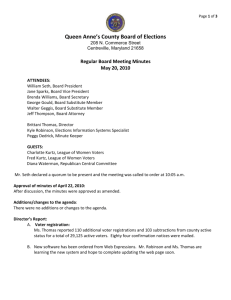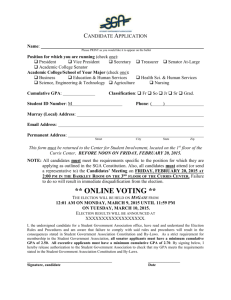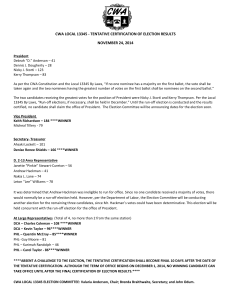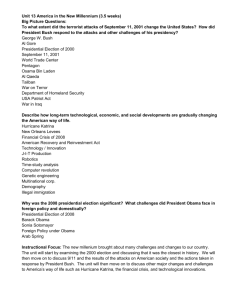FEDERAL ELECTION COMMISSION
advertisement
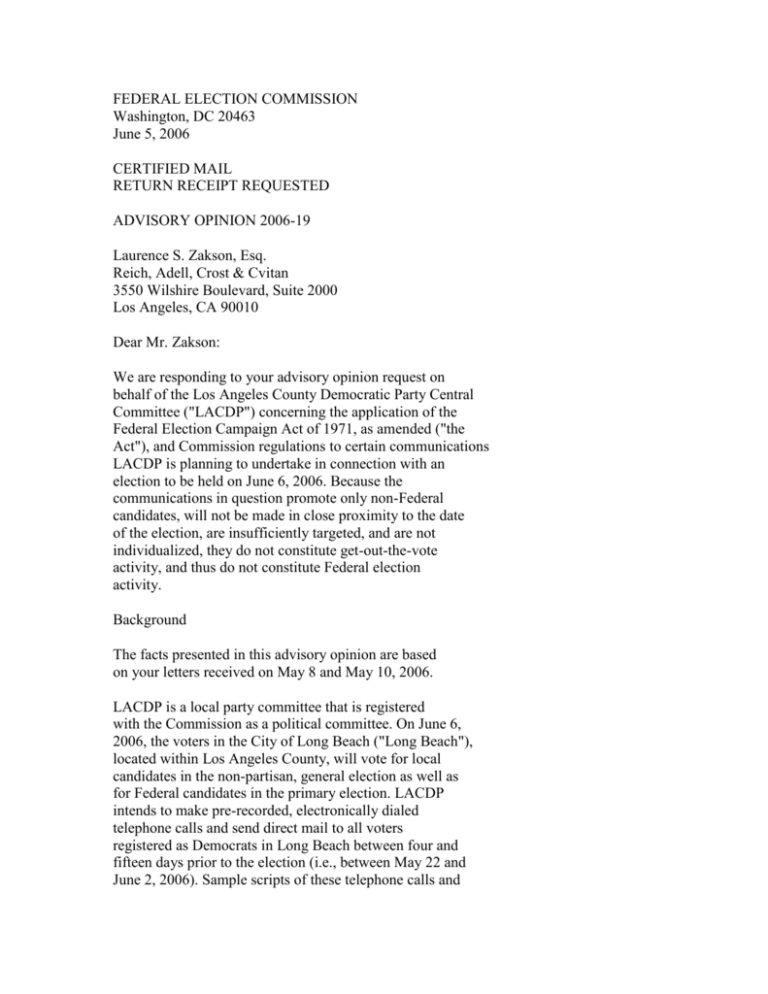
FEDERAL ELECTION COMMISSION Washington, DC 20463 June 5, 2006 CERTIFIED MAIL RETURN RECEIPT REQUESTED ADVISORY OPINION 2006-19 Laurence S. Zakson, Esq. Reich, Adell, Crost & Cvitan 3550 Wilshire Boulevard, Suite 2000 Los Angeles, CA 90010 Dear Mr. Zakson: We are responding to your advisory opinion request on behalf of the Los Angeles County Democratic Party Central Committee ("LACDP") concerning the application of the Federal Election Campaign Act of 1971, as amended ("the Act"), and Commission regulations to certain communications LACDP is planning to undertake in connection with an election to be held on June 6, 2006. Because the communications in question promote only non-Federal candidates, will not be made in close proximity to the date of the election, are insufficiently targeted, and are not individualized, they do not constitute get-out-the-vote activity, and thus do not constitute Federal election activity. Background The facts presented in this advisory opinion are based on your letters received on May 8 and May 10, 2006. LACDP is a local party committee that is registered with the Commission as a political committee. On June 6, 2006, the voters in the City of Long Beach ("Long Beach"), located within Los Angeles County, will vote for local candidates in the non-partisan, general election as well as for Federal candidates in the primary election. LACDP intends to make pre-recorded, electronically dialed telephone calls and send direct mail to all voters registered as Democrats in Long Beach between four and fifteen days prior to the election (i.e., between May 22 and June 2, 2006). Sample scripts of these telephone calls and a draft of the direct-mail piece are attached to this advisory opinion. See Attachment A. The telephone scripts state that Election Day is June 6, a certain candidate is endorsed by the Democratic Party for Long Beach Mayor, and voters are urged to vote for that mayoral candidate on June 6, 2006. The direct-mail piece conveys a similar message, and also identifies municipal candidates endorsed by LACDP for City Council and School Board. Both the telephone scripts and the direct-mail piece state the date on which the election will be held, but neither refers to any candidate for Federal office. See id. Question Presented Do LACDP's planned communications to all registered Democrats in Long Beach, California constitute "Federal election activity" that must be paid for entirely with Federal funds or a mix of Federal funds and Levin funds? Legal Analysis and Conclusions No, LACDP's planned communications to all registered Democrats in Long Beach, California do not constitute "Federal election activity" that must be paid for entirely with Federal funds or a mix of Federal funds and Levin funds. Accordingly, LACDP may pay for the planned communications entirely out of non-Federal funds. See 11 CFR 100.24(c)(1).1 The Bipartisan Campaign Reform Act of 2002, Pub. L. No. 107-155, 116 Stat. 81 (2002) ("BCRA"), amended the Act by adding a new term, "Federal election activity" ("FEA"), to describe certain activities that State, district, and local party committees must pay for with either Federal funds or a combination of Federal and Levin funds.2 2 U.S.C. 431(20) and 441i(b)(1). BCRA's requirements regarding FEA apply to all State, district, and local party committees and organizations, regardless of whether they are registered as political committees with the Commission. Id. As amended by BCRA, the Act specifies that voter identification, get-out-the-vote ("GOTV") activity, and generic campaign activity (collectively, "Type II FEA") constitute FEA only when these activities are conducted "in connection with an election in which a candidate for Federal office appears on the ballot." 2 U.S.C. 431(20)(A)(ii); 11 CFR 100.24(b)(2). As part of the definition of "Federal election activity," the Commission also defined the phrase "in connection with an election in which a candidate for Federal office appears on the ballot" ("Type II FEA time period"). See 11 CFR 100.24(a)(1); see also Explanation and Justification for Final Rules on Prohibited and Excessive Contributions: Non-Federal Funds or Soft Money, 67 Fed. Reg. 49064 (July 29, 2002); Explanation and Justification for Interim Final Rule on Definition of Federal Election Activity, 71 Fed. Reg. 14357 (March 22, 2006). In States such as California that conduct primaries, the Type II FEA time period begins on the date of the earliest filing deadline for access to the primary election ballot for Federal candidates and ends on the date of the general election, up to and including the date of any general runoff election.3 See 11 CFR 100.24(a)(1)(i). Thus the Type II FEA time period in California in 2006 is from March 10, 2006 to November 7, 2006.4 The definition of "Federal election activity" includes a definition of "get-out-the-vote activity." See 11 CFR 100.24(a)(3). "Get-out-the-vote activity" means "contacting registered voters by telephone, in person, or by other individualized means, to assist them in engaging in the act of voting." Id. Get-out-the-vote activity "includes, but is not limited to: (i) Providing to individual voters information such as the date of the election, the times when polling places are open, and the location of particular polling places; and (ii) Offering to transport or actually transporting voters to the polls." Id. In two recent Explanations and Justifications, the Commission provided additional guidance with respect to the meaning of the complementary terms "individualized means" and "assist," as used in the definition of "get-out-the-vote activity." In 2002, the Commission stated that "GOTV has a very particular purpose: assisting registered voters to take any and all necessary steps to get to the polls and cast their ballots, or to vote by absentee ballot or other means provided by law. The Commission understands this purpose to be narrower and more specific than the broader purposes of generally increasing public support for a candidate or decreasing public support for an opposing candidate." 67 Fed. Reg. at 49067. In 2006, the Commission reiterated this view, stating, "[I]n the Commission's extensive enforcement experience, general exhortations to register to vote and to vote are so common in political party communications that including encouragement to register to vote and to vote would be overly broad, is not necessary to effectively implement BCRA, and could have an adverse impact on grassroots political activities." 71 Fed. Reg. at 8929. For this reason, the Commission explained that it "declines to impose FEA funding restrictions on State, district, and local party committees' mere `encouragement' of registering to vote or voting." Id. The Commission considers several facts in your request as relevant to the analysis of whether the proposed communications would be GOTV activities. First, the communications promote the election of only non-Federal candidates. Second, LACDP will conduct the proposed communications four or more days prior to the election; the more removed from election day, the less effect the communications are likely to have on motivating recipients to go to the polls. A communication made several days prior to an election is more likely to be a "general exhortation" to vote or "mere encouragement" to vote, as opposed to a communication that assists a voter in engaging in the act of voting by individualized means. Third, there is no indication that LACDP has engaged in any activity to target these communications to any specific subset of Democratic voters. Rather, LACDP intends to send the communications to all registered Democrats in Long Beach. The proposed directmail piece is a "form letter" that will not provide any individualized information to any particular recipient (such as the location of the particular recipient's polling place). The proposed pre-recorded, electronically dialed telephone calls are the functional equivalent of a "form letter" and, similarly, do not provide any individualized information to any particular recipient. Thus, the planned communications are generic in nature and do not provide any individualized assistance to voters. Fourth, the communications contain only the date of the election and do not include such additional information as the hours and location of the individual voter's polling place. Merely including the date of an election in a communication that advocates the election or defeat of only State and local candidates does not turn that communication into GOTV activity. Based on these facts, the Commission concludes that LACDP's proposed communications do not constitute assisting voters in engaging in the act of voting by individualized means. See 11 CFR 100.24(a)(3). Thus, the proposed communications would not be GOTV activities, and therefore are excluded from the definition of Federal election activity under 11 CFR 100.24(c)(1). This response constitutes an advisory opinion concerning the application of the Act and Commission regulations to the specific transaction or activity set forth in your request. See 2 U.S.C. 437f. The Commission emphasizes that if there is a change in any of the facts or assumptions presented, and such facts or assumptions are material to a conclusion presented in this advisory opinion, then the requestor may not rely on that conclusion as support for its proposed activity. Sincerely, (signed) Michael E. Toner Chairman FEDERAL ELECTION COMMISSION Washington, DC 20463 CONCURRING OPINION IN ADVISORY OPINION 2006-19 OF COMMISSIONER HANS A. VON SPAKOVSKY The Federal Election Commission has approved Advisory Opinion 2006-19 for the Los Angeles County Democratic Party Central Committee ("the LACDP") by a vote of 5-1. The opinion, dated June 5, 2006, advises the LACDP that its proposed communications to municipal election voters do not constitute "get-out-the-vote activity" under the Bipartisan Campaign Reform Act of 2002 ("BCRA"), and therefore are not subject to the restrictions and funding requirements imposed by federal campaign finance law. I voted with the majority and agree fully with the Advisory Opinion issued. I write separately only to detail the existence of additional grounds for finding that the proposed activity does not constitute Federal election activity. The City of Long Beach, California, is holding a municipal general election on June 6, 2006. (This election is referred to both as a "run-off" election and a "concurrent" election.) The City of Long Beach held a nonpartisan primary election on April 11, 2006.5 The election on June 6, 2006, features those races in which no candidate received a majority of the votes cast in April.6 Incidentally, June 6 is also the date that the State of California is holding its state primary elections.7 The LACDP wishes to make voters aware of which candidates it has endorsed in the municipal general election and encourage voters to support these candidates. The municipal general election, like the April 11 primary, is nonpartisan. The State primary ballot, however, is partisan, and voters will cast either a Democratic or Republican ballot. Thus, voters will not be made aware of the municipal election candidates' partisan affiliations or tendencies simply by looking at the ballot. The LACDP's desire to make its proposed communications is certainly understandable in these circumstances. When Long Beach voters go to the polls on June 6, they will confront an unusual situation. Each polling place will feature two separate voting locations. At one location, voters will vote a ballot dedicated to the municipal candidates running for Mayor, City Council, and School Board. At the second location, voters will vote a different ballot dedicated to county, State, and Federal primary candidates. As the City of Long Beach's government website states: On Tuesday, June 6, residents will vote at one polling place on two different ballots; one for City candidates and one for State and County candidates and issues. Voters will visit two sign-in tables at the same polling place, and will use two different voting systems to cast their ballots. Absentee voters will need to vote and send in two ballots, one for the City and another for the County and State.8 In other words, voters will have the choice of voting one or both ballots. According to the City of Long Beach, two ballots will be used because "Tuesday June 6th 2006 is a concurrent election, when the city's election takes place on the same day as the Statewide Primary. In the City of Long Beach, city ballots need to be cast and counted separately from the county, because the City of Long Beach uses a different voting system than the county."9 The City of Long Beach obviously regards its municipal elections as separate and distinct from county, State, and Federal elections. The LACDP's proposed activity relates exclusively to the municipal ballot. The Bipartisan Campaign Reform Act of 2002 ("BCRA") defined the term "Federal election activity" to include, in relevant part, "voter identification, get-outthe-vote activity, or generic campaign activity conducted in connection with an election in which a candidate for Federal office appears on the ballot (regardless of whether a candidate for State or local office also appears on the ballot)."10 Obviously, there is no Federal candidate on the municipal ballot. Thus, not only are the proposed communications not GOTV activity, they are also not being "conducted in connection with an election in which a candidate for Federal office appears on the ballot." The plain and unambiguous language of the statute indicates that the LACDP's proposed activity is not "Federal election activity," and is thus not subject to the restrictions of federal campaign finance law. June 5, 2006 ______________/S/_________________ Commissioner Hans A. von Spakovsky _______________________________ 1 The allocation requirement set forth at 11 CFR 106.7(c)(5) is inapplicable to the communications at issue. The section applies only to certain communications that do not promote or oppose a Federal candidate or non-Federal candidate. As noted above, the proposed communications are candidatespecific. 2 "Federal funds" are funds subject to the amount limitations, source prohibitions, and reporting requirements of the Act. See 11 CFR 300.2(g). "Levin funds" are funds raised by State, district, and local party committees pursuant to the restrictions in 11 CFR 300.31 and disbursed subject to the restrictions in 11 CFR 300.32. See 11 CFR 300.2(i). 3 In States that do not hold primary elections, the Type II FEA time period begins on January 1 of each even-numbered year and ends on the date of the general election. See 11 CFR 100.24(a)(1)(i). 4 This date assumes that there will be no general runoff election. 5 See City of Long Beach Charter, Art. XIX, 1901 ("The primary and general municipal elections for elective officers of the City shall be held in even numbered years, on the second Tuesday in April and the first Tuesday after the first Monday in June, respectively . . . ."), available at http://cms.longbeach.gov/cityclerk/refer/charter/intro.htm. 6 See City of Long Beach Charter, Art. XIX, 1906 ("In the event that any candidate for nomination to an elective office shall receive a majority of the votes cast for all the candidates for nomination to such office at any primary nominating election, the candidate so receiving such majority shall be deemed to be and declared by the City Council to be elected to such office."), available at http://cms.longbeach.gov/cityclerk/refer/charter/intro.htm. Sample ballots provided by the City of Long Beach, City Clerk's Department, indicate that voters will cast votes for Mayor, City Council Member (Districts 2, 3, and 5), and Board of Education Member (District 5) on June 6. 7 The state primary ballots include county, State, and Federal offices, along with State ballot initiative measures. 8 http://www.longbeach.gov/news/displaynews.asp?NewsID=1756 (last visited May 22, 2006). 9 http://www.2votetuesday.com/ (last visited May 22, 2006). 10 2 U.S.C. 431(20)(A)(ii) (emphasis added).
